
Photo from wikipedia
Haemorrhagic enteritis virus (HEV) causes clinical haemorrhagic enteritis in young poults and/or subclinical immunosuppression which is often associated with colibacillosis. This disease is controlled with live vaccines worldwide, however, importation… Click to show full abstract
Haemorrhagic enteritis virus (HEV) causes clinical haemorrhagic enteritis in young poults and/or subclinical immunosuppression which is often associated with colibacillosis. This disease is controlled with live vaccines worldwide, however, importation of HEV vaccines or cells that support HEV propagation are not permitted in Australia. A major experiment in isolators was conducted to test the safety and efficacy of a putative HEV vaccine. The study had a factorial design with four factors namely vaccination age (28 and 42 days of age), vaccine dose (0, 105 , 106 , 107 genomic copies of HEV vaccine), challenge with HEV (yes, no) and vaccination-challenge interval (7, 21 or 42 days). A total of 315 poults were used providing 6-8 birds per treatment combination. Turkey growth rate, mortality, pathological findings, anti-HEV antibodies and viral load were examined. Vaccination lead to significant increases in anti HEV antibody over the following 2-4 weeks. Overall, vaccination with 106 and 107 was protective against increase in relative splenic weight and splenic viral load in challenged birds. Clinical haemorrhagic enteritis was not induced by any treatment but there was an increased incidence of airsacculitis in groups receiving either HEV vaccine or challenge virus compared to the negative control birds (25.8-29.3% vs. 9.4%, P < 0.05). Growth rate, mortality and relative bursal weight were unaffected by vaccination. This laboratory level study indicates that the putative vaccine is safe and likely to be efficacious, but may cause elevated levels of airsacculitis. These findings require confirmation in larger scale field trials.
Journal Title: Australian veterinary journal
Year Published: 2019
Link to full text (if available)
Share on Social Media: Sign Up to like & get
recommendations!